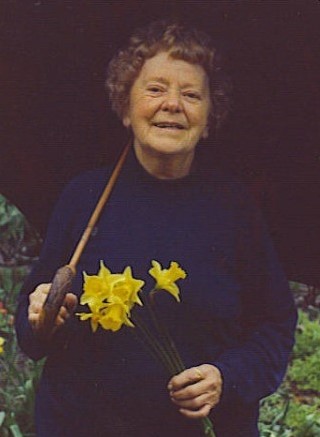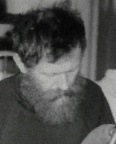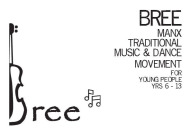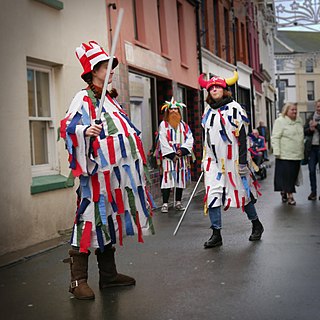
The music of the Isle of Man reflects Celtic, Norse and other influences, including those from its neighbours, Scotland, Ireland, England and Wales. The Isle of Man is a small island nation in the Irish Sea, between Great Britain and Ireland.
Yn Chruinnaght is a cultural festival in the Isle of Man which celebrates Manx music, Manx language and culture, and links with other Celtic cultures.

The culture of the Isle of Man is influenced by its Celtic and, to a lesser extent, its Norse origins, though its close proximity to the United Kingdom, popularity as a UK tourist destination, and recent mass immigration by British migrant workers has meant that British influence has been dominant since the Revestment period. Recent revival campaigns have attempted to preserve the surviving vestiges of Manx culture after a long period of Anglicisation, and significant interest in the Manx language, history and musical tradition has been the result.

Literature in the Manx language is known from the 16th century. Early works were often religious in theme, including translations of the Book of Common Prayer, the Bible and Milton's Paradise Lost. Edward Faragher, who published poems, stories and translations, is considered the last major native writer of the language. The historian A. W. Moore collected traditional Manx-language songs and ballads in publications towards the end of the 19th century.

Hop-tu-Naa is a Celtic festival celebrated in the Isle of Man on 31 October. It is the celebration of the traditional Gaelic festival of Samhain, the start of winter. It is thought to be the oldest unbroken tradition in the Isle of Man.

SS (RMS) Ellan Vannin was built as an iron paddle steamer in 1860 at Meadowside, Glasgow for the Isle of Man Steam Packet Company. She was originally named Mona's Isle - the second ship in the company's history to be so named. She served for 23 years under that name before being rebuilt, re-engined and renamed in 1883. As Ellan Vannin she served for a further 26 years before being lost in a storm on 3 December 1909 in Liverpool Bay.

Thomas Brian Stowell, also known as Brian Mac Stoyll, was a Manx radio personality, linguist, physicist, and author. He was formerly Yn Lhaihder to the Parliament of the Isle of Man, Tynwald. He is considered one of the primary people behind the revival of the Manx language.
John Joseph Kneen was a Manx linguist and scholar renowned for his seminal works on Manx grammar and on the place names and personal names of the Isle of Man. He is also a significant Manx dialect playwright and translator of Manx poetry. He is commonly best known for his translation of the Manx National Anthem into Manx.

Mona Douglas was a Manx cultural activist, folklorist, poet, novelist and journalist. She is recognised as the main driving force behind the modern revival of Manx culture and is acknowledged as the most influential Manx poet of the 20th century, but she is best known for her often controversial work to preserve and revive traditional Manx folk music and dance. She was involved in a great number of initiatives to revive interest and activity in Manx culture, including societies, classes, publications and youth groups. The most notable and successful of these was Yn Chruinnaght.

The Reih Bleeaney Vanannan is the Isle of Man's most prestigious annual award for culture. It is presented by Culture Vannin to the person or group who, in the opinion of the panel of assessors, has made the most outstanding contribution to Manx culture. It is officially presented by the President of Culture Vannin, normally in January each year.
Aeglagh Vannin was a youth group in the Isle of Man whose purpose was the engagement with and revitalisation of Manx language, history and culture. It was established by Mona Douglas in 1931, went through a number of mutations, and faded out in the 1970s. It is best remembered for its central role in the revival of Manx folk dancing.

Colin Jerry was a Manx cultural activist best known for his contributions to Manx music through his books, Kiaull yn Theay, published in two volumes. He was awarded the Reih Bleeaney Vanannan in 1991 for his contributions to Manx culture which were 'extensive and staggering.'
Rinkaghyn Vannin is an important book of 28 Manx dances, mostly collected by Mona Douglas, which was published in 1983 by Sleih gyn Thie.
Juan Noa was the pen-name of John Henry Cleator, a Manx dialect poet and playwright active from the 1920s to the 1960s in the Isle of Man.

Hunt the Wren is a traditional custom carried out on the Isle of Man on the 26 December, St. Stephen's Day. It consists of groups of people going around villages and towns singing and dancing a traditional song and dance around a decorated wren pole.
The Flitter Dance is a traditional dance from the Isle of Man associated with Good Friday. It was collected by Mona Douglas in the 1940s or 50s and is popular among younger Manx dancers today.
Doug Fargher also known as Doolish y Karagher or Yn Breagagh, was a Manx language activist, author, and radio personality who was involved with the revival of the Manx language on the Isle of Man in the 20th century. He is best known for his English-Manx Dictionary (1979), the first modern dictionary for the Manx language. Fargher was involved in the promotion of Manx language, culture and nationalist politics throughout his life.

Bree is a youth educational movement organised by Culture Vannin on the Isle of Man that gives children between the ages 10 and 18 the opportunity to learn traditional Manx music, dance, and culture. Bree is a Manx word that means 'vitality or 'energy'. The movement organises the annual workshop weekend every autumn and also runs monthly sessions through the year.

Shennaghys Jiu(English: Tradition Today) is a four-day youth music and performing arts festival on the Isle of Man. The festival's aim is to give young performers of traditional Manx music and dance the opportunity to come together in a non-competitive environment, and share culture with the other Celtic nations.

The White Boys is the traditional mummers' play of the Isle of Man.











